Report on the Significant Impacts of Climate Change
VerifiedAdded on 2022/03/10
|7
|2065
|14
Report
AI Summary
This report examines the multifaceted impacts of climate change, focusing on its effects on the human environment and global ecosystems. It details the rise in sea levels, caused by thermal expansion and melting glaciers, leading to coastal submersion, saltwater intrusion, and the extinction of certain tree species. The report also highlights the impact of rising temperatures, including hyperthermia, the spread of vector-borne diseases, and the influence on freshwater ecosystems, affecting water quality and international relations. Furthermore, the report discusses the threats to marine ecosystems, the hydrologic cycle, and the increase in severe weather events like hurricanes and floods. It concludes by addressing the health complications associated with climate change, such as the increase in vector-borne diseases and heat stress, emphasizing the need for public awareness and policies to mitigate climate change induced activities.
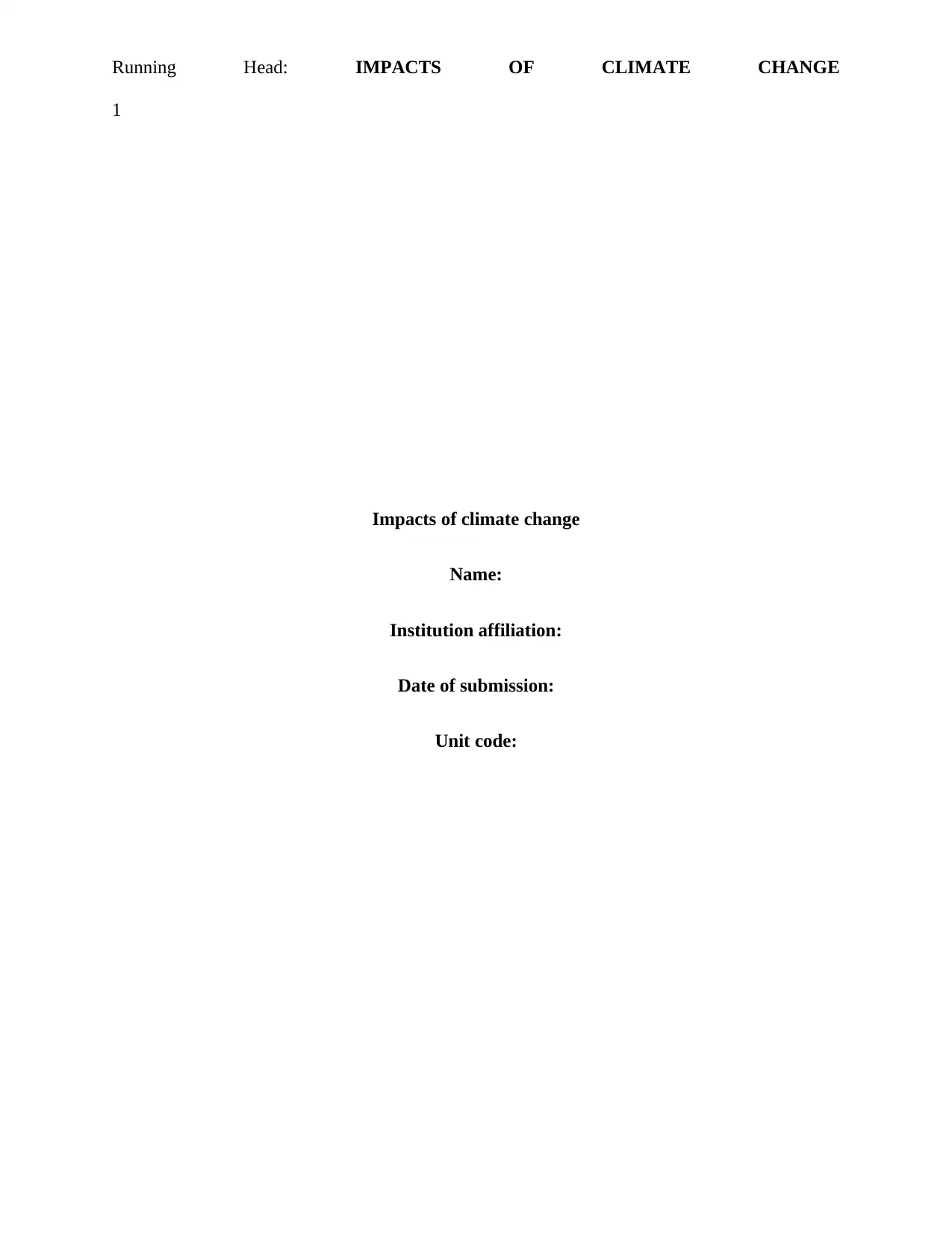
Running Head: IMPACTS OF CLIMATE CHANGE
1
Impacts of climate change
Name:
Institution affiliation:
Date of submission:
Unit code:
1
Impacts of climate change
Name:
Institution affiliation:
Date of submission:
Unit code:
Paraphrase This Document
Need a fresh take? Get an instant paraphrase of this document with our AI Paraphraser
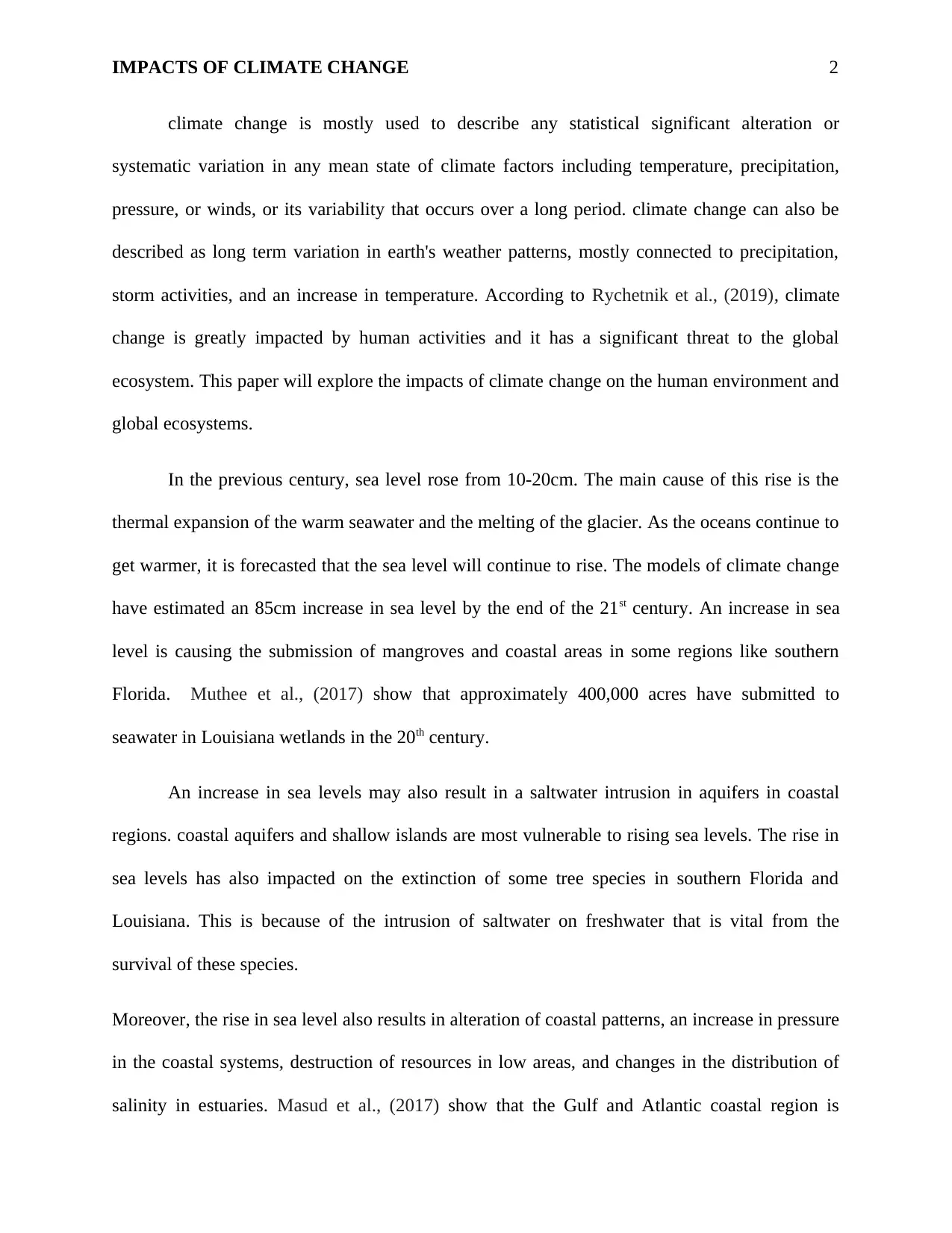
IMPACTS OF CLIMATE CHANGE 2
climate change is mostly used to describe any statistical significant alteration or
systematic variation in any mean state of climate factors including temperature, precipitation,
pressure, or winds, or its variability that occurs over a long period. climate change can also be
described as long term variation in earth's weather patterns, mostly connected to precipitation,
storm activities, and an increase in temperature. According to Rychetnik et al., (2019), climate
change is greatly impacted by human activities and it has a significant threat to the global
ecosystem. This paper will explore the impacts of climate change on the human environment and
global ecosystems.
In the previous century, sea level rose from 10-20cm. The main cause of this rise is the
thermal expansion of the warm seawater and the melting of the glacier. As the oceans continue to
get warmer, it is forecasted that the sea level will continue to rise. The models of climate change
have estimated an 85cm increase in sea level by the end of the 21st century. An increase in sea
level is causing the submission of mangroves and coastal areas in some regions like southern
Florida. Muthee et al., (2017) show that approximately 400,000 acres have submitted to
seawater in Louisiana wetlands in the 20th century.
An increase in sea levels may also result in a saltwater intrusion in aquifers in coastal
regions. coastal aquifers and shallow islands are most vulnerable to rising sea levels. The rise in
sea levels has also impacted on the extinction of some tree species in southern Florida and
Louisiana. This is because of the intrusion of saltwater on freshwater that is vital from the
survival of these species.
Moreover, the rise in sea level also results in alteration of coastal patterns, an increase in pressure
in the coastal systems, destruction of resources in low areas, and changes in the distribution of
salinity in estuaries. Masud et al., (2017) show that the Gulf and Atlantic coastal region is
climate change is mostly used to describe any statistical significant alteration or
systematic variation in any mean state of climate factors including temperature, precipitation,
pressure, or winds, or its variability that occurs over a long period. climate change can also be
described as long term variation in earth's weather patterns, mostly connected to precipitation,
storm activities, and an increase in temperature. According to Rychetnik et al., (2019), climate
change is greatly impacted by human activities and it has a significant threat to the global
ecosystem. This paper will explore the impacts of climate change on the human environment and
global ecosystems.
In the previous century, sea level rose from 10-20cm. The main cause of this rise is the
thermal expansion of the warm seawater and the melting of the glacier. As the oceans continue to
get warmer, it is forecasted that the sea level will continue to rise. The models of climate change
have estimated an 85cm increase in sea level by the end of the 21st century. An increase in sea
level is causing the submission of mangroves and coastal areas in some regions like southern
Florida. Muthee et al., (2017) show that approximately 400,000 acres have submitted to
seawater in Louisiana wetlands in the 20th century.
An increase in sea levels may also result in a saltwater intrusion in aquifers in coastal
regions. coastal aquifers and shallow islands are most vulnerable to rising sea levels. The rise in
sea levels has also impacted on the extinction of some tree species in southern Florida and
Louisiana. This is because of the intrusion of saltwater on freshwater that is vital from the
survival of these species.
Moreover, the rise in sea level also results in alteration of coastal patterns, an increase in pressure
in the coastal systems, destruction of resources in low areas, and changes in the distribution of
salinity in estuaries. Masud et al., (2017) show that the Gulf and Atlantic coastal region is
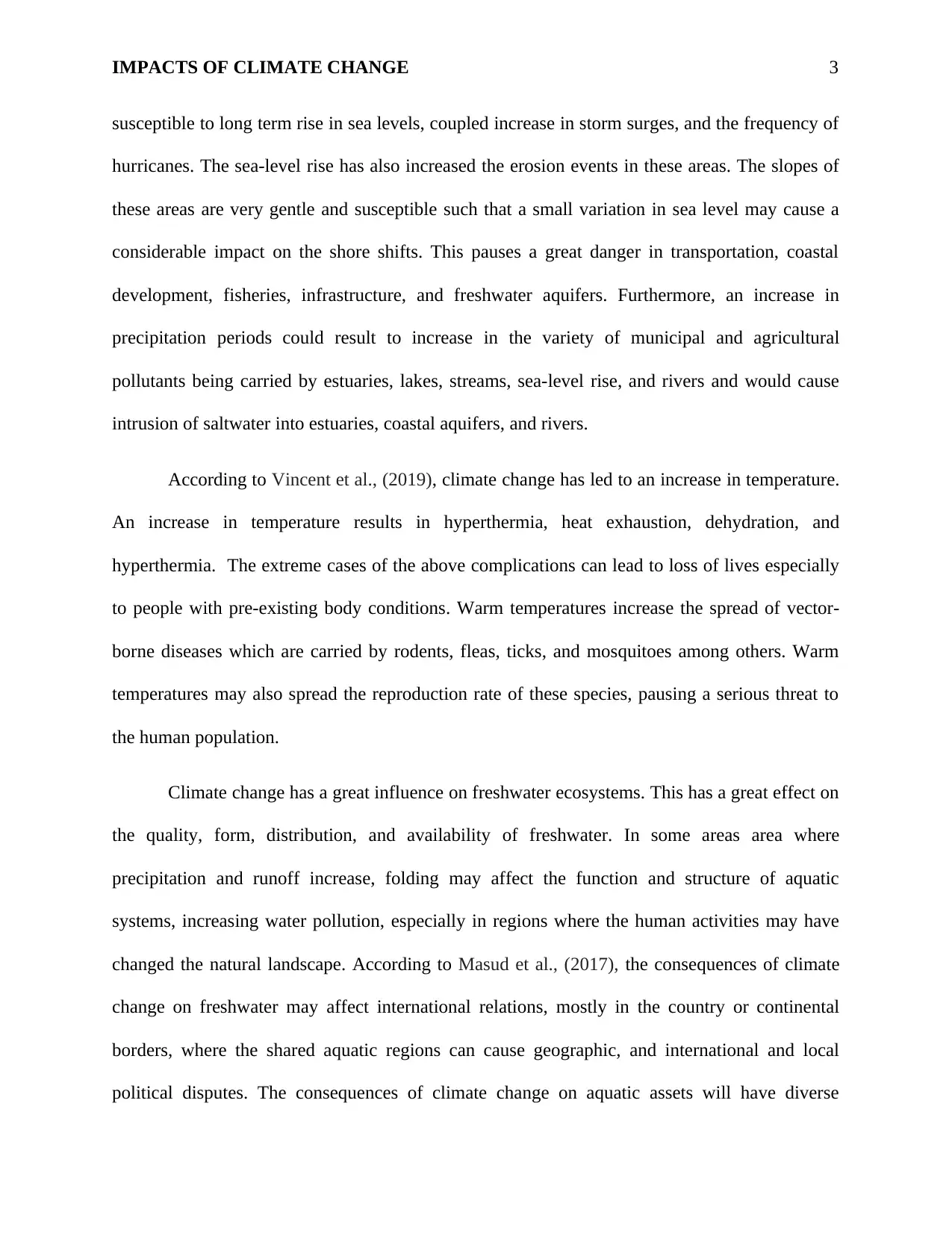
IMPACTS OF CLIMATE CHANGE 3
susceptible to long term rise in sea levels, coupled increase in storm surges, and the frequency of
hurricanes. The sea-level rise has also increased the erosion events in these areas. The slopes of
these areas are very gentle and susceptible such that a small variation in sea level may cause a
considerable impact on the shore shifts. This pauses a great danger in transportation, coastal
development, fisheries, infrastructure, and freshwater aquifers. Furthermore, an increase in
precipitation periods could result to increase in the variety of municipal and agricultural
pollutants being carried by estuaries, lakes, streams, sea-level rise, and rivers and would cause
intrusion of saltwater into estuaries, coastal aquifers, and rivers.
According to Vincent et al., (2019), climate change has led to an increase in temperature.
An increase in temperature results in hyperthermia, heat exhaustion, dehydration, and
hyperthermia. The extreme cases of the above complications can lead to loss of lives especially
to people with pre-existing body conditions. Warm temperatures increase the spread of vector-
borne diseases which are carried by rodents, fleas, ticks, and mosquitoes among others. Warm
temperatures may also spread the reproduction rate of these species, pausing a serious threat to
the human population.
Climate change has a great influence on freshwater ecosystems. This has a great effect on
the quality, form, distribution, and availability of freshwater. In some areas area where
precipitation and runoff increase, folding may affect the function and structure of aquatic
systems, increasing water pollution, especially in regions where the human activities may have
changed the natural landscape. According to Masud et al., (2017), the consequences of climate
change on freshwater may affect international relations, mostly in the country or continental
borders, where the shared aquatic regions can cause geographic, and international and local
political disputes. The consequences of climate change on aquatic assets will have diverse
susceptible to long term rise in sea levels, coupled increase in storm surges, and the frequency of
hurricanes. The sea-level rise has also increased the erosion events in these areas. The slopes of
these areas are very gentle and susceptible such that a small variation in sea level may cause a
considerable impact on the shore shifts. This pauses a great danger in transportation, coastal
development, fisheries, infrastructure, and freshwater aquifers. Furthermore, an increase in
precipitation periods could result to increase in the variety of municipal and agricultural
pollutants being carried by estuaries, lakes, streams, sea-level rise, and rivers and would cause
intrusion of saltwater into estuaries, coastal aquifers, and rivers.
According to Vincent et al., (2019), climate change has led to an increase in temperature.
An increase in temperature results in hyperthermia, heat exhaustion, dehydration, and
hyperthermia. The extreme cases of the above complications can lead to loss of lives especially
to people with pre-existing body conditions. Warm temperatures increase the spread of vector-
borne diseases which are carried by rodents, fleas, ticks, and mosquitoes among others. Warm
temperatures may also spread the reproduction rate of these species, pausing a serious threat to
the human population.
Climate change has a great influence on freshwater ecosystems. This has a great effect on
the quality, form, distribution, and availability of freshwater. In some areas area where
precipitation and runoff increase, folding may affect the function and structure of aquatic
systems, increasing water pollution, especially in regions where the human activities may have
changed the natural landscape. According to Masud et al., (2017), the consequences of climate
change on freshwater may affect international relations, mostly in the country or continental
borders, where the shared aquatic regions can cause geographic, and international and local
political disputes. The consequences of climate change on aquatic assets will have diverse
⊘ This is a preview!⊘
Do you want full access?
Subscribe today to unlock all pages.

Trusted by 1+ million students worldwide
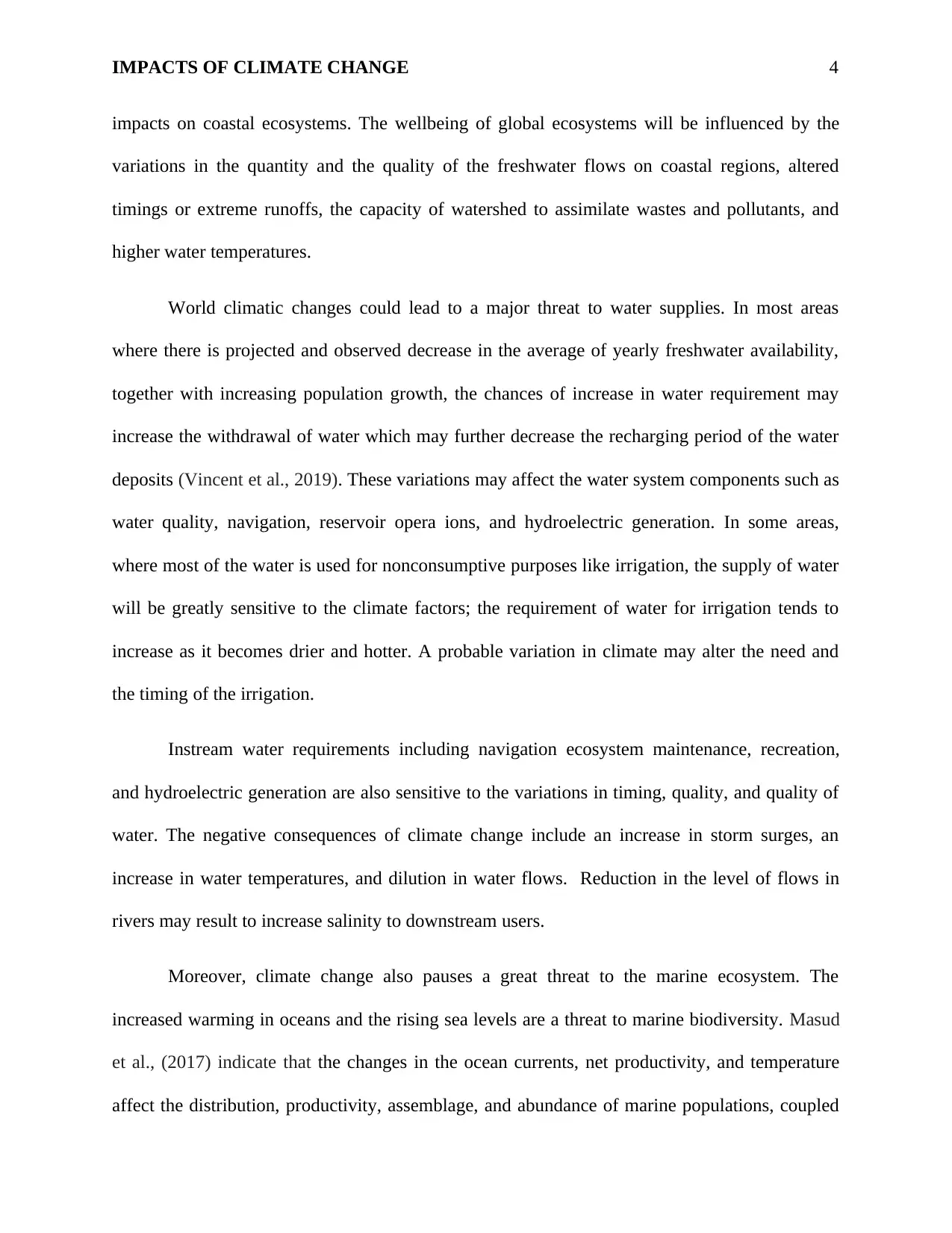
IMPACTS OF CLIMATE CHANGE 4
impacts on coastal ecosystems. The wellbeing of global ecosystems will be influenced by the
variations in the quantity and the quality of the freshwater flows on coastal regions, altered
timings or extreme runoffs, the capacity of watershed to assimilate wastes and pollutants, and
higher water temperatures.
World climatic changes could lead to a major threat to water supplies. In most areas
where there is projected and observed decrease in the average of yearly freshwater availability,
together with increasing population growth, the chances of increase in water requirement may
increase the withdrawal of water which may further decrease the recharging period of the water
deposits (Vincent et al., 2019). These variations may affect the water system components such as
water quality, navigation, reservoir opera ions, and hydroelectric generation. In some areas,
where most of the water is used for nonconsumptive purposes like irrigation, the supply of water
will be greatly sensitive to the climate factors; the requirement of water for irrigation tends to
increase as it becomes drier and hotter. A probable variation in climate may alter the need and
the timing of the irrigation.
Instream water requirements including navigation ecosystem maintenance, recreation,
and hydroelectric generation are also sensitive to the variations in timing, quality, and quality of
water. The negative consequences of climate change include an increase in storm surges, an
increase in water temperatures, and dilution in water flows. Reduction in the level of flows in
rivers may result to increase salinity to downstream users.
Moreover, climate change also pauses a great threat to the marine ecosystem. The
increased warming in oceans and the rising sea levels are a threat to marine biodiversity. Masud
et al., (2017) indicate that the changes in the ocean currents, net productivity, and temperature
affect the distribution, productivity, assemblage, and abundance of marine populations, coupled
impacts on coastal ecosystems. The wellbeing of global ecosystems will be influenced by the
variations in the quantity and the quality of the freshwater flows on coastal regions, altered
timings or extreme runoffs, the capacity of watershed to assimilate wastes and pollutants, and
higher water temperatures.
World climatic changes could lead to a major threat to water supplies. In most areas
where there is projected and observed decrease in the average of yearly freshwater availability,
together with increasing population growth, the chances of increase in water requirement may
increase the withdrawal of water which may further decrease the recharging period of the water
deposits (Vincent et al., 2019). These variations may affect the water system components such as
water quality, navigation, reservoir opera ions, and hydroelectric generation. In some areas,
where most of the water is used for nonconsumptive purposes like irrigation, the supply of water
will be greatly sensitive to the climate factors; the requirement of water for irrigation tends to
increase as it becomes drier and hotter. A probable variation in climate may alter the need and
the timing of the irrigation.
Instream water requirements including navigation ecosystem maintenance, recreation,
and hydroelectric generation are also sensitive to the variations in timing, quality, and quality of
water. The negative consequences of climate change include an increase in storm surges, an
increase in water temperatures, and dilution in water flows. Reduction in the level of flows in
rivers may result to increase salinity to downstream users.
Moreover, climate change also pauses a great threat to the marine ecosystem. The
increased warming in oceans and the rising sea levels are a threat to marine biodiversity. Masud
et al., (2017) indicate that the changes in the ocean currents, net productivity, and temperature
affect the distribution, productivity, assemblage, and abundance of marine populations, coupled
Paraphrase This Document
Need a fresh take? Get an instant paraphrase of this document with our AI Paraphraser
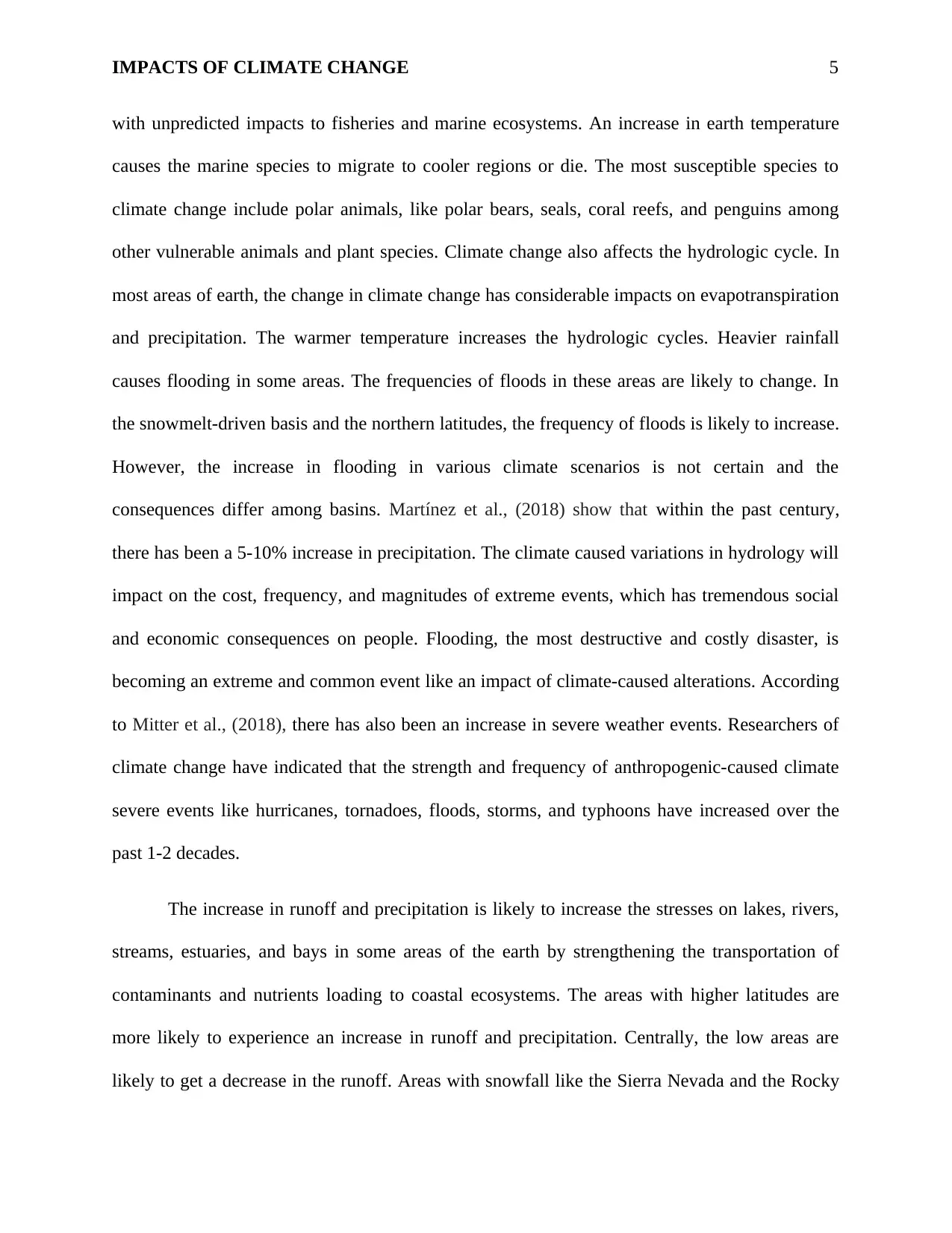
IMPACTS OF CLIMATE CHANGE 5
with unpredicted impacts to fisheries and marine ecosystems. An increase in earth temperature
causes the marine species to migrate to cooler regions or die. The most susceptible species to
climate change include polar animals, like polar bears, seals, coral reefs, and penguins among
other vulnerable animals and plant species. Climate change also affects the hydrologic cycle. In
most areas of earth, the change in climate change has considerable impacts on evapotranspiration
and precipitation. The warmer temperature increases the hydrologic cycles. Heavier rainfall
causes flooding in some areas. The frequencies of floods in these areas are likely to change. In
the snowmelt-driven basis and the northern latitudes, the frequency of floods is likely to increase.
However, the increase in flooding in various climate scenarios is not certain and the
consequences differ among basins. Martínez et al., (2018) show that within the past century,
there has been a 5-10% increase in precipitation. The climate caused variations in hydrology will
impact on the cost, frequency, and magnitudes of extreme events, which has tremendous social
and economic consequences on people. Flooding, the most destructive and costly disaster, is
becoming an extreme and common event like an impact of climate-caused alterations. According
to Mitter et al., (2018), there has also been an increase in severe weather events. Researchers of
climate change have indicated that the strength and frequency of anthropogenic-caused climate
severe events like hurricanes, tornadoes, floods, storms, and typhoons have increased over the
past 1-2 decades.
The increase in runoff and precipitation is likely to increase the stresses on lakes, rivers,
streams, estuaries, and bays in some areas of the earth by strengthening the transportation of
contaminants and nutrients loading to coastal ecosystems. The areas with higher latitudes are
more likely to experience an increase in runoff and precipitation. Centrally, the low areas are
likely to get a decrease in the runoff. Areas with snowfall like the Sierra Nevada and the Rocky
with unpredicted impacts to fisheries and marine ecosystems. An increase in earth temperature
causes the marine species to migrate to cooler regions or die. The most susceptible species to
climate change include polar animals, like polar bears, seals, coral reefs, and penguins among
other vulnerable animals and plant species. Climate change also affects the hydrologic cycle. In
most areas of earth, the change in climate change has considerable impacts on evapotranspiration
and precipitation. The warmer temperature increases the hydrologic cycles. Heavier rainfall
causes flooding in some areas. The frequencies of floods in these areas are likely to change. In
the snowmelt-driven basis and the northern latitudes, the frequency of floods is likely to increase.
However, the increase in flooding in various climate scenarios is not certain and the
consequences differ among basins. Martínez et al., (2018) show that within the past century,
there has been a 5-10% increase in precipitation. The climate caused variations in hydrology will
impact on the cost, frequency, and magnitudes of extreme events, which has tremendous social
and economic consequences on people. Flooding, the most destructive and costly disaster, is
becoming an extreme and common event like an impact of climate-caused alterations. According
to Mitter et al., (2018), there has also been an increase in severe weather events. Researchers of
climate change have indicated that the strength and frequency of anthropogenic-caused climate
severe events like hurricanes, tornadoes, floods, storms, and typhoons have increased over the
past 1-2 decades.
The increase in runoff and precipitation is likely to increase the stresses on lakes, rivers,
streams, estuaries, and bays in some areas of the earth by strengthening the transportation of
contaminants and nutrients loading to coastal ecosystems. The areas with higher latitudes are
more likely to experience an increase in runoff and precipitation. Centrally, the low areas are
likely to get a decrease in the runoff. Areas with snowfall like the Sierra Nevada and the Rocky
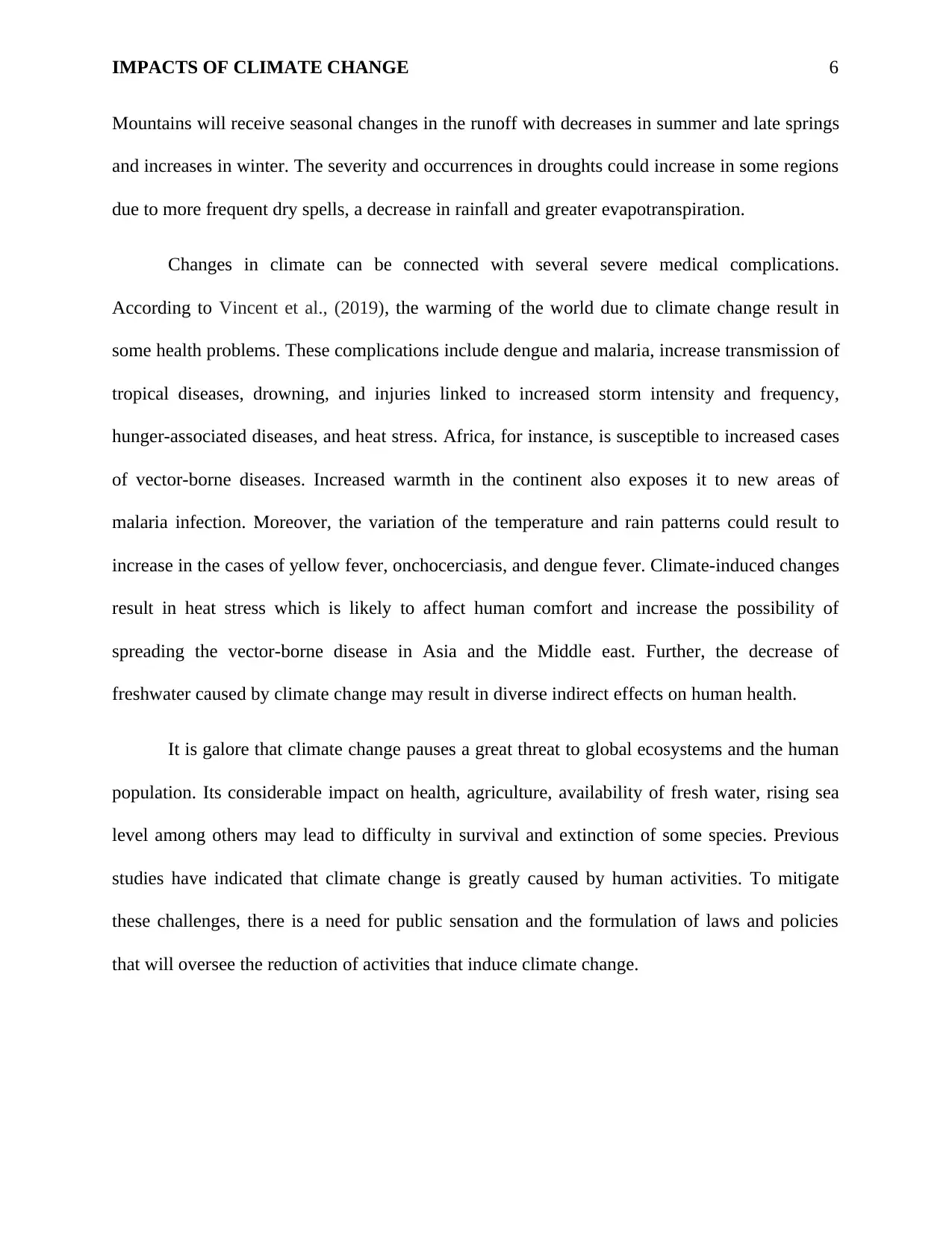
IMPACTS OF CLIMATE CHANGE 6
Mountains will receive seasonal changes in the runoff with decreases in summer and late springs
and increases in winter. The severity and occurrences in droughts could increase in some regions
due to more frequent dry spells, a decrease in rainfall and greater evapotranspiration.
Changes in climate can be connected with several severe medical complications.
According to Vincent et al., (2019), the warming of the world due to climate change result in
some health problems. These complications include dengue and malaria, increase transmission of
tropical diseases, drowning, and injuries linked to increased storm intensity and frequency,
hunger-associated diseases, and heat stress. Africa, for instance, is susceptible to increased cases
of vector-borne diseases. Increased warmth in the continent also exposes it to new areas of
malaria infection. Moreover, the variation of the temperature and rain patterns could result to
increase in the cases of yellow fever, onchocerciasis, and dengue fever. Climate-induced changes
result in heat stress which is likely to affect human comfort and increase the possibility of
spreading the vector-borne disease in Asia and the Middle east. Further, the decrease of
freshwater caused by climate change may result in diverse indirect effects on human health.
It is galore that climate change pauses a great threat to global ecosystems and the human
population. Its considerable impact on health, agriculture, availability of fresh water, rising sea
level among others may lead to difficulty in survival and extinction of some species. Previous
studies have indicated that climate change is greatly caused by human activities. To mitigate
these challenges, there is a need for public sensation and the formulation of laws and policies
that will oversee the reduction of activities that induce climate change.
Mountains will receive seasonal changes in the runoff with decreases in summer and late springs
and increases in winter. The severity and occurrences in droughts could increase in some regions
due to more frequent dry spells, a decrease in rainfall and greater evapotranspiration.
Changes in climate can be connected with several severe medical complications.
According to Vincent et al., (2019), the warming of the world due to climate change result in
some health problems. These complications include dengue and malaria, increase transmission of
tropical diseases, drowning, and injuries linked to increased storm intensity and frequency,
hunger-associated diseases, and heat stress. Africa, for instance, is susceptible to increased cases
of vector-borne diseases. Increased warmth in the continent also exposes it to new areas of
malaria infection. Moreover, the variation of the temperature and rain patterns could result to
increase in the cases of yellow fever, onchocerciasis, and dengue fever. Climate-induced changes
result in heat stress which is likely to affect human comfort and increase the possibility of
spreading the vector-borne disease in Asia and the Middle east. Further, the decrease of
freshwater caused by climate change may result in diverse indirect effects on human health.
It is galore that climate change pauses a great threat to global ecosystems and the human
population. Its considerable impact on health, agriculture, availability of fresh water, rising sea
level among others may lead to difficulty in survival and extinction of some species. Previous
studies have indicated that climate change is greatly caused by human activities. To mitigate
these challenges, there is a need for public sensation and the formulation of laws and policies
that will oversee the reduction of activities that induce climate change.
⊘ This is a preview!⊘
Do you want full access?
Subscribe today to unlock all pages.

Trusted by 1+ million students worldwide
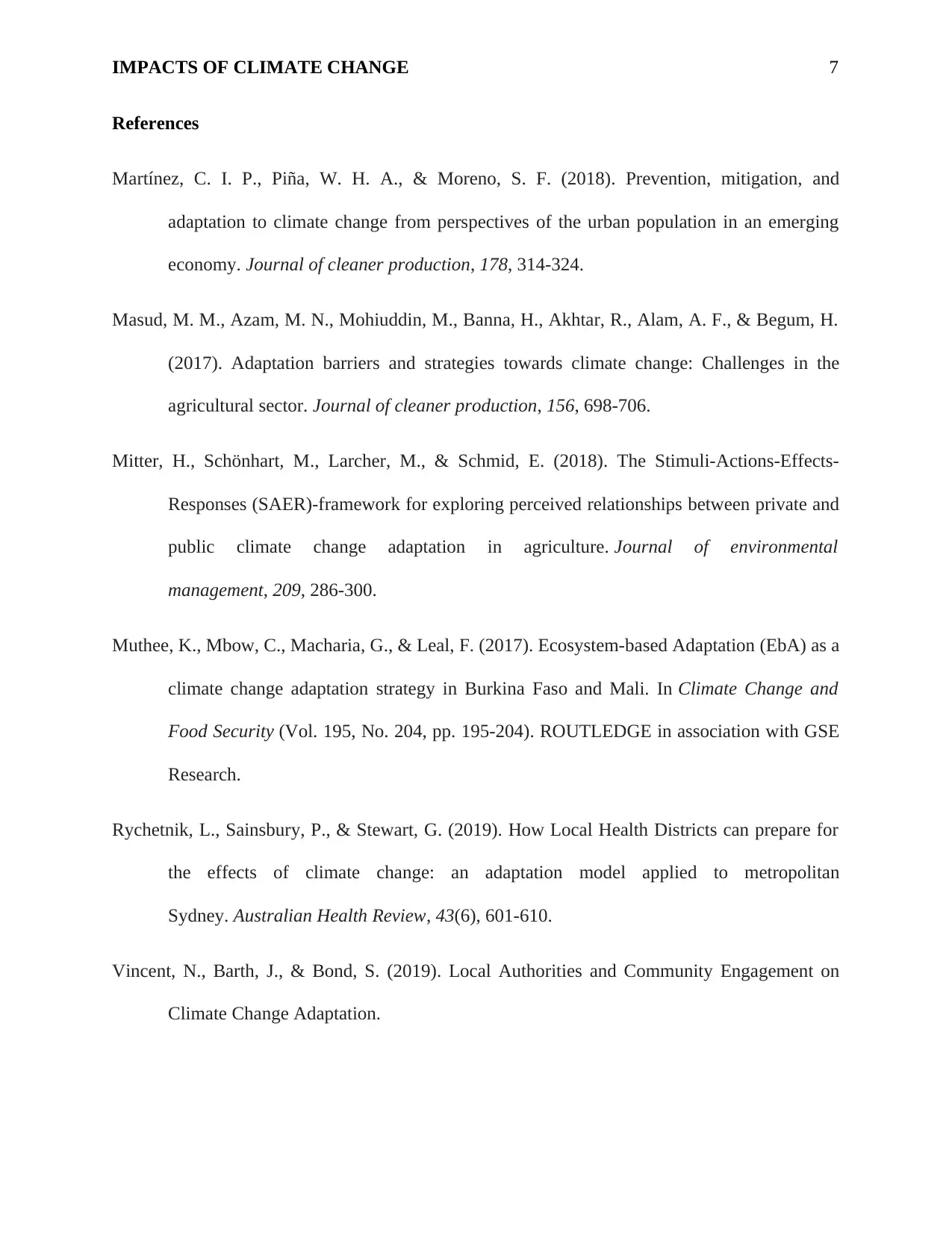
IMPACTS OF CLIMATE CHANGE 7
References
Martínez, C. I. P., Piña, W. H. A., & Moreno, S. F. (2018). Prevention, mitigation, and
adaptation to climate change from perspectives of the urban population in an emerging
economy. Journal of cleaner production, 178, 314-324.
Masud, M. M., Azam, M. N., Mohiuddin, M., Banna, H., Akhtar, R., Alam, A. F., & Begum, H.
(2017). Adaptation barriers and strategies towards climate change: Challenges in the
agricultural sector. Journal of cleaner production, 156, 698-706.
Mitter, H., Schönhart, M., Larcher, M., & Schmid, E. (2018). The Stimuli-Actions-Effects-
Responses (SAER)-framework for exploring perceived relationships between private and
public climate change adaptation in agriculture. Journal of environmental
management, 209, 286-300.
Muthee, K., Mbow, C., Macharia, G., & Leal, F. (2017). Ecosystem-based Adaptation (EbA) as a
climate change adaptation strategy in Burkina Faso and Mali. In Climate Change and
Food Security (Vol. 195, No. 204, pp. 195-204). ROUTLEDGE in association with GSE
Research.
Rychetnik, L., Sainsbury, P., & Stewart, G. (2019). How Local Health Districts can prepare for
the effects of climate change: an adaptation model applied to metropolitan
Sydney. Australian Health Review, 43(6), 601-610.
Vincent, N., Barth, J., & Bond, S. (2019). Local Authorities and Community Engagement on
Climate Change Adaptation.
References
Martínez, C. I. P., Piña, W. H. A., & Moreno, S. F. (2018). Prevention, mitigation, and
adaptation to climate change from perspectives of the urban population in an emerging
economy. Journal of cleaner production, 178, 314-324.
Masud, M. M., Azam, M. N., Mohiuddin, M., Banna, H., Akhtar, R., Alam, A. F., & Begum, H.
(2017). Adaptation barriers and strategies towards climate change: Challenges in the
agricultural sector. Journal of cleaner production, 156, 698-706.
Mitter, H., Schönhart, M., Larcher, M., & Schmid, E. (2018). The Stimuli-Actions-Effects-
Responses (SAER)-framework for exploring perceived relationships between private and
public climate change adaptation in agriculture. Journal of environmental
management, 209, 286-300.
Muthee, K., Mbow, C., Macharia, G., & Leal, F. (2017). Ecosystem-based Adaptation (EbA) as a
climate change adaptation strategy in Burkina Faso and Mali. In Climate Change and
Food Security (Vol. 195, No. 204, pp. 195-204). ROUTLEDGE in association with GSE
Research.
Rychetnik, L., Sainsbury, P., & Stewart, G. (2019). How Local Health Districts can prepare for
the effects of climate change: an adaptation model applied to metropolitan
Sydney. Australian Health Review, 43(6), 601-610.
Vincent, N., Barth, J., & Bond, S. (2019). Local Authorities and Community Engagement on
Climate Change Adaptation.
1 out of 7
Related Documents
Your All-in-One AI-Powered Toolkit for Academic Success.
+13062052269
info@desklib.com
Available 24*7 on WhatsApp / Email
![[object Object]](/_next/static/media/star-bottom.7253800d.svg)
Unlock your academic potential
Copyright © 2020–2025 A2Z Services. All Rights Reserved. Developed and managed by ZUCOL.





